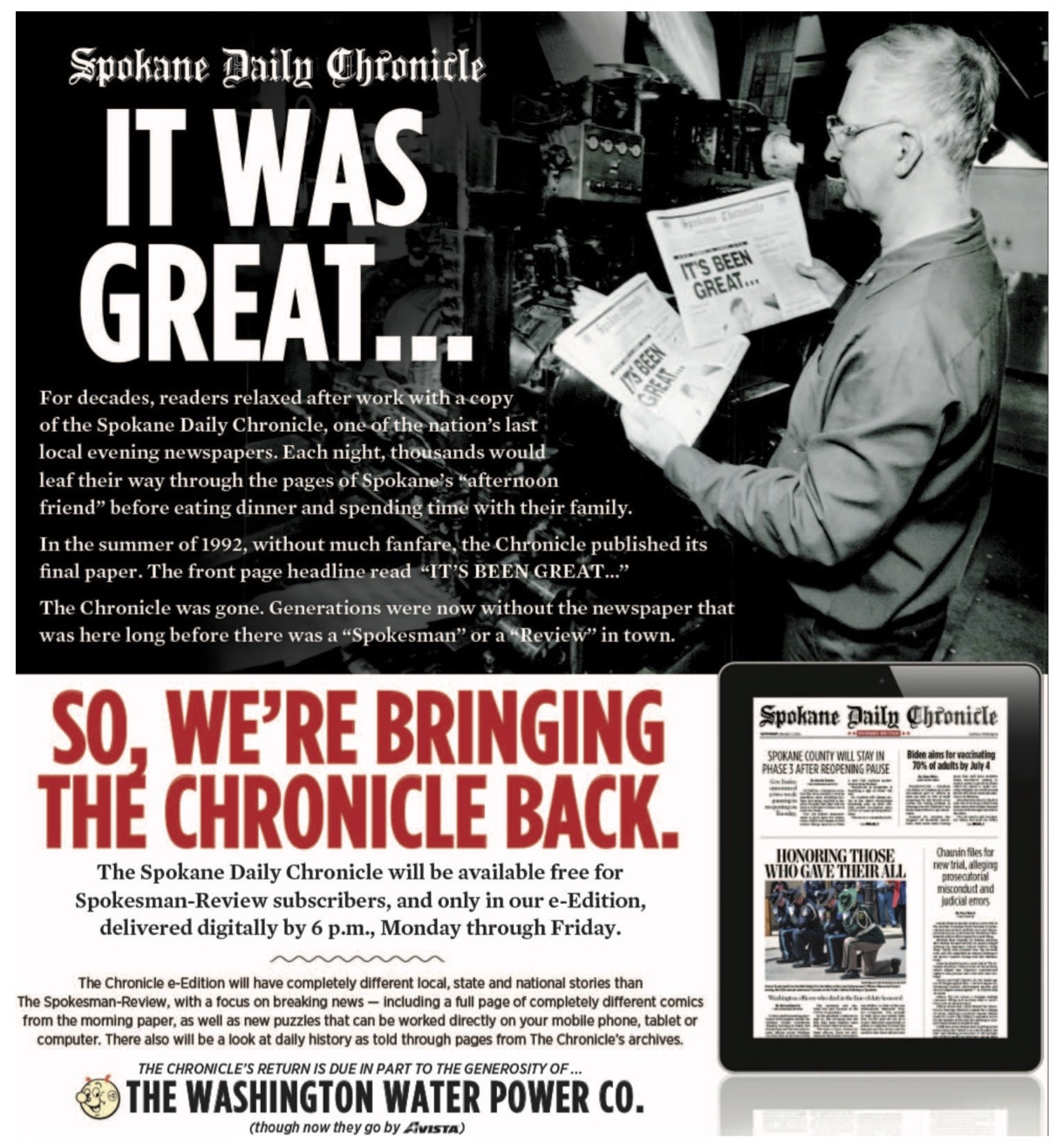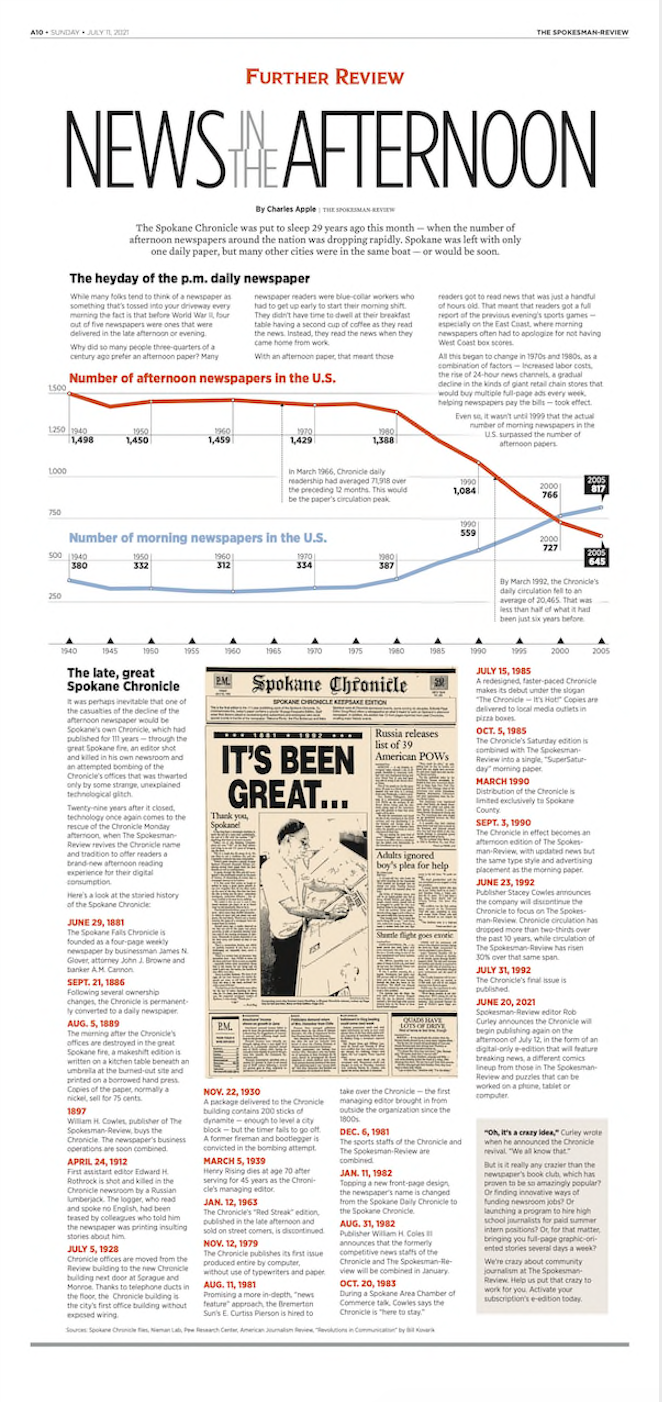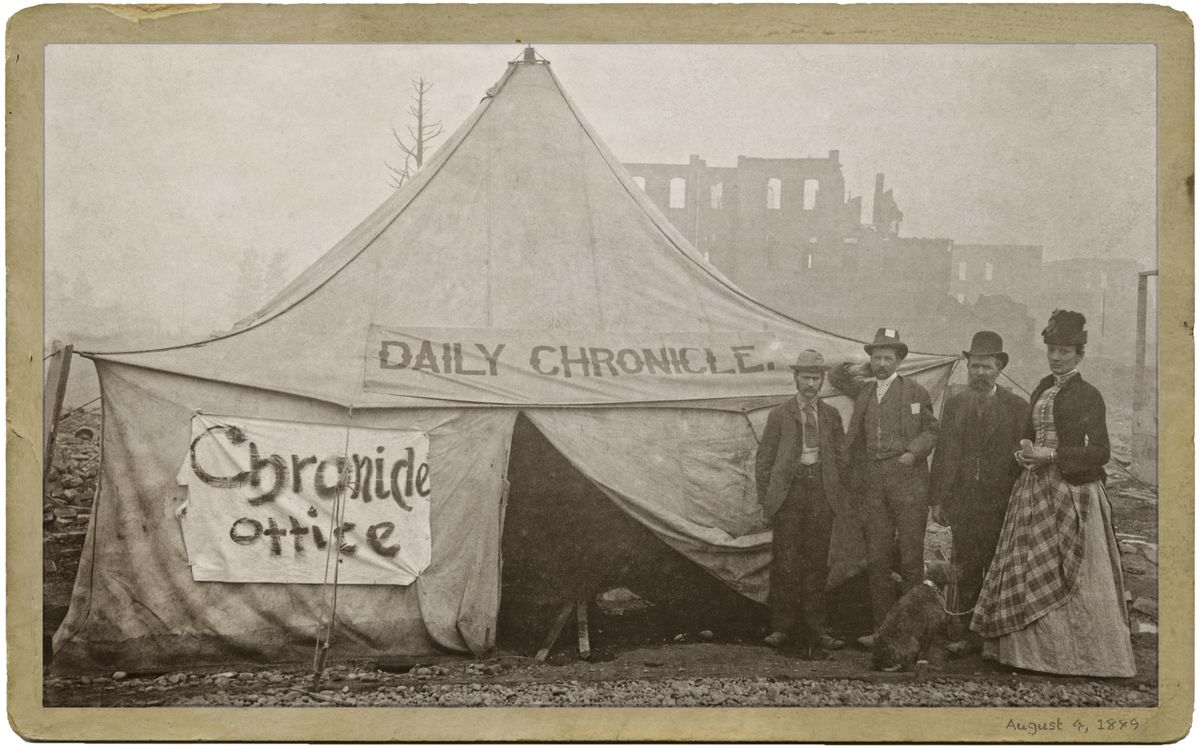When Rob Curley speaks in public as the editor-in-chief of The (Spokane, Washington) Spokesman-Review, he usually hears about another newspaper.
“Well, you know, we were a Chronicle family,” people tell him.
It was a reminder of a time when many cities had more than one newspaper, often one in the morning and another in the afternoon or evening.
The Spokane Daily Chronicle was Spokane’s evening edition, owned by the same family that owns The Spokesman-Review. The two papers once had two separate newsrooms, separate audiences and fought for scoops. Eventually, the newsrooms merged, and in 1992, the publisher closed the Chronicle, which had fallen from a high of 72,000 print subscribers to about 20,000.
Almost 30 years later, it came back — in a way. The Chronicle is now an eight-page e-edition for Spokesman-Review subscribers, produced by current Spokesman-Review staff, with fresh content and lots of nostalgia.
While many legacy newsrooms are working on attracting new subscribers, the Chronicle isn’t a play to build new audiences. It’s meant to keep the audience the 127-year-old paper still has, who’ve seen their subscription costs rise every year. (The average rate is about $1 a day.)
“We were realists on this,” Curley said. “It wasn’t about how are we going to make this a bigger pie, it was how are we going to hang on to the pie that we have when we know we’re going to continue to push subscription prices?”
The results?
“So far, it’s working,” publisher Stacey Cowles told Poynter in an email.
The Chronicle currently has an average Sunday circulation of 40,000, and 25,000 for weekdays.
Since launching the Chronicle:
- The Spokesman-Review’s e-editions have seen a 25% increase overall in users
- The e-editions saw a 31% increase in new users
- And the paper had a 41% increase in total pageviews, said Tyler Pisani, digital audience and engagement manager.
- There’s been a 4.5% increase in activation of digital subscriptions.
- And, since launching the Chronicle, digital subscriptions have increased by 2.25%. The Spokesman-Review has almost reached 10,000 digital subscribers.
“… We hope some are those who used to say they’d never ever read us online,” Cowles said. “We hope a few took the plunge and may now consider E reading as rewarding if not more so than paper. Either way, more engagement will help with churn and support hitting our subscription revenue goal.”
At a time when newspapers are more likely to cut staff, print and pages or close completely, here’s how it happened.

A house ad from the Spokesman-Review (Courtesy: Spokesman-Review)
The gateway edition
In the last two years, Cowles pushed Curley to add extra pages to the e-edition.
“And I pushed back,” Curley said. “I felt like, though for a newspaper our size we have a much bigger newsroom than we should, it’s still not big enough because we don’t have the design hubs. We do it all in house.”
(The newsroom has 60 full time employees and 20 part-timers.)
But during the pandemic, Curley started to mull another idea. What if The Spokesman-Review could give readers something more in the afternoon? And what if it tied that product to the extinct paper a lot of people loved?
“They always think I’m nuts,” Curley said, “but this was next level nuts.”
Maybe not completely. Poynter’s Rick Edmonds reported last year that e-editions have become a central business approach for the Tampa Bay Times (which Poynter owns) and The Arkansas Democrat-Gazette. Better News reported in March that The (Columbia, South Carolina) State found e-editions to be a key way to increase loyalty. And The Kansas City Star’s editor Mike Fannin told readers in August to expect an evening edition in September.
When newspapers came out more often than just in the morning, they served different functions. The morning papers got the who, what, when and where, Curley said, and the afternoon papers followed up with the how and why.
Now, he said, the roles have flipped. In a time when everyone can know almost everything thanks to the internet, the morning paper offers context.
The Chronicle, usually available to readers between 6 and 7 p.m., runs the latest news reported that day. It also includes a full page of photos in a nod to the Chronicle’s once-strong photography, a reprint from a historic front page, regional stories from other local newsrooms and new comics and puzzles.
The Chronicle also offers older readers something else — a chance to get people online.
“Our view is the e-edition is the gateway drug to our web presence for traditional readers,” Cowles said. “If they love it enough, it could help solve our huge manufacturing and distribution cost headache. But additional online pages have to be meaningful to make a difference. More stock listings don’t cut it.”

This full-page graphic ran the week before the return of the Chronicle. (Courtesy Spokesman-Review)
A sense of place
When she first heard that the Spokesman-Review was bringing back the evening paper as an e-edition, Madeline Happold did think it was a little nuts.
“It had shuttered before I was even born,” said the audience engagement editor.
Staff brought some former Chronicle journalists in to get their feedback and understand what made that paper. It helped Happold realize how embedded that publication was in the community, from families that subscribed to the Chronicle to families who worked there. And people in Spokane love their history, she said.
“I don’t know if this would work in every market.”
It takes Happold about four hours a day to design the Chronicle, which publishes five days a week.
Former Chronicle and Spokesman-Review reporter Karen Dorn Steele isn’t quite sure what to make of the Chronicle’s return. It’s not the competitive paper with its own staff that it once was, she said. But it’s probably good business to widen the audience. Curley has brought back another old favorite, she noted, Dorothy Dean’s vintage recipes.
“It’s a good experiment,” she said of the Chronicle.
And if it keeps people reading, well, that’s something these days.
“If our core readers stick with us through everything that happens,” Curley said, including losing Saturday print editions and a rise in subscription rates, “… then we’ve won.”







